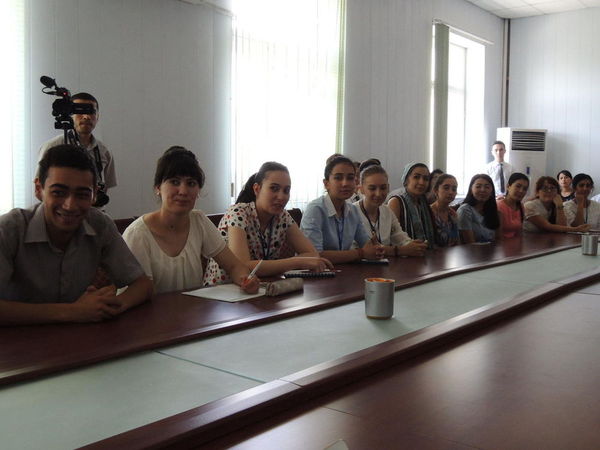At a prime location along the Silk Road sits Uzbekistan's ancient city of Samarkand, which flourished for centuries as a center of learning and culture. After about seven hours to Tashkent via a connecting flight from Seoul and then four hours by car, in a town deep in central Asia, I met students enamored with Japan and majoring in Japanese language studies. Their unanimous message to our group from Nagoya University was that they wanted to learn Japanese from Japanese instructors. What is the background to this story? And what can we do for them?
Meidai has an office in the Uzbekistani capital of Tashkent, one of our several bases in Asia. Two years ago, senior officials from the two countries agreed on plans to create an innovation center at Tashkent State Technical University(TSTU), and Meidai is serving as a coordinator to make it happen. A major aim of our mission this time was to visit universities and other institutions to discuss research exchanges.
It was at the Samarkand State Institute of Foreign Languages that we met the students who major in Japanese. Japanese language courses are very popular there, and 220 of the nearly 2,000 students in the department are learning Japanese, including 80 who have chosen Japanese as their primary foreign language. Volunteer Japanese instructors started teaching there in 1998, and until recently the Japan International Cooperation Agency (JICA) was providing volunteers, but that all ended in March last year. Today Japanese language classes are only being taught by six local instructors.
Prof. Turobjonov S.M., the rector of TSTU, spoke about the current status and future hopes for Japanese language education, including cooperation with Japanese universities, and mentioned that what they especially need now is native Japanese instructors. Then students made presentations about their activities, and finished up with the same message that they really wanted Japanese instructors.
Why is Japanese so popular? We asked the students. They had various responses, like I became interested in Japan after watching anime shows on the web, I am interested in Japanese literature, or I want to study economics or law at a Japanese university. Some students said they wanted a tourism-related career after graduating. Many high school students apparently go to tourist spots in Samarkand visited by Japanese to talk to them or volunteer to guide them on tours to practice speaking.

Japanese language students who gathered for us at the Samarkand State Institute of Foreign Languages
Uzbekistan has an underlying friendly attitude toward Japan. Japanese prisoners of war were sent there from Siberia for forced labor after World War II, but ended up being well-received as a hard-working and polite people. Even today, people are talking about the fact that the Navoi Opera and Ballet Theater in Tashkent, constructed with the participation of the Japanese detainees, did not collapse even in an earthquake.
Prof. Katsuya Ichihashi in Faculty of Law, Nagoya University, who stayed in the country as a JICA expert at the start of the 2000s, explains that the NHK television drama "Oshin" was being broadcast there at the time. The protagonist of the story, Oshin, is a persevering woman who turned her family's fortunes around in one generation. The show was very popular especially among women there because of Oshin's similarities with Uzbekistani women. They also felt a sense of affinity, with cultural similarities such as the respect and order between older and younger generations, and customs such as gathering together to drink tea. He thinks that this good old-fashioned image has combined with the fact of being a country of leading technologies, to give people a positive impression of Japan......> read more on the Meidai Watch
 |
Atsuko Tsuji: Earned B.A. in Arts, College of Arts and Sciences, the University of Tokyo in 1976. Joined The Asahi Shimbun Company in 1979 as a journalist and wrote many articles in science and technology area for newspaper and magazines published by the company including editorial pieces. Knight Science Journalism Fellow at Massachusetts Institute of Technology in 1989 and Reuters Fellow at University of Oxford in 2014. Designated Professor of Nagoya University's Institute of International Education and Exchange since October 2016. |